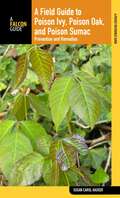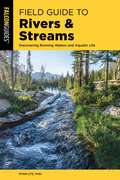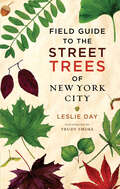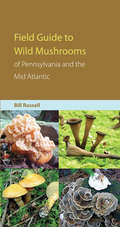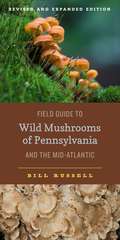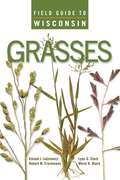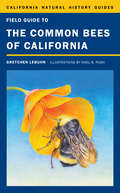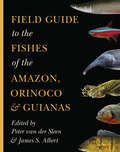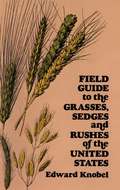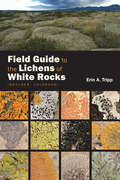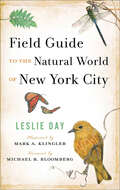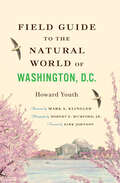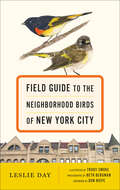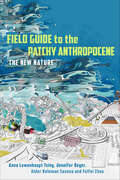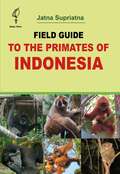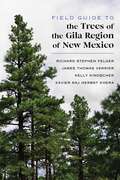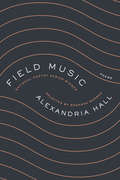- Table View
- List View
Field Guide to Poison Ivy, Poison Oak, and Poison Sumac: Prevention And Remedies
by Susan Carol HauserThis handbook takes the mystery out of identifying these common weeds and provides useful antidotes for treating their irritating, itching rashes. Photos show the plants in every season, and detailed drawings help readers pinpoint the culprit in the woods or in their own backyards. Hauser distinguishes between home remedies that really work and those that can actually aggravate the poison, tells how to treat each poison differently, and explains how to prevent the offending vines from growing in the yard. The perfect reference for homeowners, parents, gardeners and hikers, this is easy to read and informative. Susan Carol Hauser is a writer and gardener who lives in Bemidji, Minnesota.
Field Guide to Rivers & Streams: Discovering Running Waters and Aquatic Life
by Ryan Utz Ph.D.In Field Guide to Rivers & Streams, Dr. Ryan Utz (Chatham University) presents a broad scientific understanding of rivers, streams, and the animals that reside within them, written accessibly for a general audience. Topics range from what causes river flows to rise and fall to the ecology of riverine fishes. Kayakers, anglers, and hikers alike will find many tools within Field Guide to Rivers & Streams to deepen their understanding of their favorite waterway.
Field Guide to Street Trees New York City
by Leslie Day“A handbook for naturalists, sidewalk denizens, apartment dwellers, dog-walkers, and bicycle riders . . . No New Yorker should be without this book.” —Wayne Cahilly, New York Botanical GardenNew York City is an urban oasis with hundreds of thousands of trees, and this guide acquaints residents and visitors alike with fifty species commonly found in the neighborhoods where people live, work, and travel. Beautiful, original drawings of leaves and stunning photographs of bark, fruit, flower, and twig accompany informative descriptions of each species. Detailed maps of the five boroughs identify all of the city’s neighborhoods, and specific addresses pinpoint where to find a good example of each tree species.Trees provide invaluable benefits to the Big Apple: they reduce the rate of respiratory disease, increase property values, cool homes and sidewalks in the summer, block the harsh winds of winter, clean the air, absorb storm water runoff, and provide habitat and food for the city’s wildlife. Bald cypress, swamp oak, silver linden, and all of New York’s most common trees are just a page turn away. Your evening walk will never be the same once you come to know the quiet giants that line the city’s streets.
Field Guide to Trees: Eastern Region
by National Audubon SocietyThe most comprehensive field guide available to the trees of North America's eastern region--a must-have for any enthusiast's day pack or home library--from the go-to reference source for over 18 million nature lovers. <p><p>Nearly 700 species of trees are detailed in beautiful, full-color photographs of leaf shape, bark, flowers, fruit, and fall leaves, and accompanied by informative text. Both compact and comprehensive, this is the ideal companion for beginner and advanced tree-peepers alike. Note: the Eastern Edition generally covers states east of the Rocky Mountains, while the Western Edition covers the Rocky Mountain range and all the states to the west of it.
Field Guide to Wild Mushrooms of Pennsylvania and the Mid-Atlantic (Keystone Books)
by Bill RussellTo most Americans, mushrooms are the brown lumps in the soup one uses to make a tuna casserole, but to a select few, mushrooms are the abundant yet often well-hidden delicacies of the forests. In spite of their rather dismal reputation, most wild mushrooms are both edible and delicious, when prepared properly. From the morel to the chanterelle and the prolific and aptly named chicken of the woods, mushrooms can easily be harvested and enjoyed, if you know where to look and what to look for. Bill Russell’s Field Guide to the Wild Mushrooms of Pennsylvania and the Mid-Atlantic helps the reader learn just that—specifically for the often-neglected East Coast mushrooms of the United States and Canada.Suited to both the novice and the experienced mushroom hunter, this book helps the reader identify mushrooms with the use of illustrations, descriptions, and environmental observations. Russell’s fifty years of experience in hunting, studying, and teaching about wild mushrooms have been carefully distilled into this easy-to-use and well-designed guide. The book is divided into the four seasons, each with its unique mushroom offerings. Each mushroom section includes a detailed description, information about the mushroom’s biology, tips on where the mushroom is most likely to be found, and a short “nutshell” description for quick reference. The book also includes color photographs of each of the mushrooms described.Russell’s Field Guide to the Wild Mushrooms of Pennsylvania and the Mid-Atlantic shows the reader not only how to identify the most common mushrooms found in the region but also how to avoid common copycats—and what to do with the mushrooms once they’re identified and harvested. With both color illustrations and insightful descriptions of one hundred of the area’s most common mushrooms, Field Guide is an indispensable reference for the curious hiker, the amateur biologist, or the adventurous chef.
Field Guide to Wild Mushrooms of Pennsylvania and the Mid-Atlantic: Revised and Expanded Edition (Keystone Books)
by Bill RussellThis revised and expanded edition of mushroom expert Bill Russell’s popular Field Guide to Wild Mushrooms of Pennsylvania and the Mid-Atlantic provides both novice and experienced mushroom foragers with detailed, easy-to-use information about more than one hundred species of these fungi, including twenty-five varieties not found in the previous guide.From the Morel to the Chanterelle to the aptly named Chicken of the Woods, mushrooms of the mid-Atlantic region can be harvested and enjoyed, if you know where to look. Each entry in this field guide contains a detailed description, current scientific classification, key updates and information from recent studies, and high-quality color photographs to aid in identification. Thoughtfully organized by season, the guide shows you how to locate and identify the most common mushrooms in the region and recognize look-alikes—and explains what to do with edible mushrooms once you’ve found them.Featuring over one hundred full-color illustrations and distilling Russell’s fifty years of experience in hunting, studying, and teaching about wild mushrooms, Field Guide to Wild Mushrooms of Pennsylvania and the Mid-Atlantic is an indispensable reference for curious hikers, amateur biologists, adventurous chefs, and mycophiles of all stripes.
Field Guide to Wild Mushrooms of Pennsylvania and the Mid-Atlantic: Revised and Expanded Edition (Keystone Books)
by Bill RussellThis revised and expanded edition of mushroom expert Bill Russell’s popular Field Guide to Wild Mushrooms of Pennsylvania and the Mid-Atlantic provides both novice and experienced mushroom foragers with detailed, easy-to-use information about more than one hundred species of these fungi, including twenty-five varieties not found in the previous guide.From the Morel to the Chanterelle to the aptly named Chicken of the Woods, mushrooms of the mid-Atlantic region can be harvested and enjoyed, if you know where to look. Each entry in this field guide contains a detailed description, current scientific classification, key updates and information from recent studies, and high-quality color photographs to aid in identification. Thoughtfully organized by season, the guide shows you how to locate and identify the most common mushrooms in the region and recognize look-alikes—and explains what to do with edible mushrooms once you’ve found them.Featuring over one hundred full-color illustrations and distilling Russell’s fifty years of experience in hunting, studying, and teaching about wild mushrooms, Field Guide to Wild Mushrooms of Pennsylvania and the Mid-Atlantic is an indispensable reference for curious hikers, amateur biologists, adventurous chefs, and mycophiles of all stripes.
Field Guide to Wisconsin Grasses
by Lynn G. Clark Emmet J. Judziewicz Robert W. Freckmann Merel R. BlackGrasses are the foremost plant family of prairies, savannas, barrens, many agricultural landscapes, lawns, and successional habitats throughout Wisconsin, yet they are notoriously difficult to identify. This field guide to 232 species of Wisconsin grasses includes more than 1,100 illustrations. Setting a new standard as the first new, illustrated midwestern grass identification manual to appear since the 1960s, it provides up-to-date, comprehensive information for naturalists, gardeners, landscapers, nursery horticulturalists, community restoration professionals, agronomists and biologists, and any outdoors lover. The book includes: #149; species descriptions and distribution maps for all 232 species #149; more than 700 color photographs accompanying species descriptions #149; drawings of most species #149; chapters on grass morphology and grasses in natural communities #149; keys to all species, including an illustrated key to genera #149; a glossary of grass terminology.
Field Guide to the Common Bees of California
by Gretchen LebuhnThis engaging and easy-to-use natural history guidebook provides a thorough overview of native and honey bee biology and offers tools for identifying the most common bees of California and the Western United States. Full-color illustrations introduce readers to more than 30 genera of native bees, noting each one's needs and habits and placing them in their wider context. The author highlights bees' ties to our own lives, the food we eat, and the habitat we provide, and suggests ways to support bees in our own backyards. In addition to helping readers understand and distinguish among major groups of bees, this guide reveals how bees are an essential part of healthy ecosystem and how many plants, including important crop plants, depend on the pollination they provide. As growing evidence points to declining bee populations, this book offers critical information about the bond between plants and pollinators, and between humans and nature. Thoroughly researched and full of new insights into the ancient process of pollination, Field Guide to the Common Bees of California; Including Bees of the Western United States is invaluable for the window it opens onto the biodiversity, adaptive range, and complexity of invertebrate communities.
Field Guide to the Fishes of the Amazon, Orinoco, and Guianas
by James S. Albert Peter van der SleenThe Amazon and Orinoco basins in northern South America are home to the highest concentration of freshwater fish species on earth, with more than 3,000 species allotted to 564 genera. Amazonian fishes include piranhas, electric eels, freshwater stingrays, a myriad of beautiful small-bodied tetras and catfishes, and the largest scaled freshwater fish in the world, the pirarucu. Field Guide to the Fishes of the Amazon, Orinoco, and Guianas provides descriptions and identification keys for all the known genera of fishes that inhabit Greater Amazonia, a vast and still mostly remote region of tropical rainforests, seasonally flooded savannas, and meandering lowland rivers.The guide’s contributors include more than fifty expert scientists. They summarize the current state of knowledge on the taxonomy, species richness, and ecology of these fish groups, and provide references to relevant literature for species-level identifications. This richly illustrated guide contains 700 detailed drawings, 190 color photos, and 500 distribution maps, which cover all genera. An extensive and illustrated glossary helps readers with the identification keys.The first complete overview of the fish diversity in the Amazon, Orinoco, and Guianas, this comprehensive guide is essential for anyone interested in the freshwater life inhabiting this part of the world.First complete overview of the fish diversity in the Amazon and Orinoco basinsContributors include more than fifty expertsIdentification keys and distribution maps for all genera190 stunning color photos 700 detailed line drawingsExtensive and illustrated glossary
Field Guide to the Forest Trees of Uganda: For Identification and Conservation
by Alan Hamilton James KalemaThis book is a guide for the identification of the indigenous forest trees of Uganda. It will be useful for those who wish to contribute towards the conservation of the forests or to plant indigenous trees. Information is provided on how to propagate and cultivate about 80 of the most valuable species. Indigenous trees provide numerous resources useful for welfare and development. They include many types of timber and non-timber forest products, such as craft materials, foods and medicines. The proximity of indigenous forest helps to moderate the local climate, making it more suitable for agriculture. Indigenous forests protect springs, therefore safeguarding water supplies more effectively than exotic trees such as pines and eucalyptus. All 450 known indigenous tree species from the forests are included. Both scientific and local names are provided, the latter in 21 languages. Local names facilitate access to knowledge and values traditionally attached to the species, useful when planning pathways of development firmly rooted in local culture. The book will be invaluable for botanists, foresters, rural development workers and members of the general public concerned about contributing to conservation and sustainable development in Uganda. Many of the species grow in neighbouring countries, so the book has relevance there too.
Field Guide to the Grasses, Sedges, and Rushes of the United States
by Edward KnobelWith its clear, easy-to-use format, accurate line drawings, and concise descriptions, Edward Knobel's Field Guide can help make you an expert at identifying the common grasses, sedges, and rushes of the United States. Over 370 of the most common species are accurately described in this handy volume: varieties of timothy, rye, foxtail, fescue, bluegrass, nutrush, cottongrass, bulrush, etc. Knobel's emphasis is upon wild varieties of these plants common to the eastern and central United States, but many cultivated strains and food grains such as rice, oats, and maize are also included.A general key on the first page of this book allows you to fit each plant into one of several basic structural categories. Further subdivisions, classified according to the structure of the ear and spikelet (the flowering part of the plant) identify the particular species. Each plant is then described according to common name, Latin name, height, color of flower and stem, texture, smell (if applicable), habitat, and even edibility. Close resemblances to other varieties are also noted, which helps to make identifications even easier. Each description is also accompanied by a drawing of an entire plant, and a second drawing of the actual spikelet (with scale of the drawing noted). The author includes a total of 28 plates and over 600 line drawings.This new Dover edition has been completely revised, with common and scientific nomenclature updated, by Mildred E. Faust, Professor of Botany, Emeritus, Syracuse University.
Field Guide to the Lichens of White Rocks: (Boulder, Colorado)
by Erin TrippField Guide to the Lichens of White Rocks is a careful examination of the lichens that occur at the ecologically important and lichenologically rich urban outcropping of Fox Hills sandstone known as White Rocks Nature Preserve, located in Boulder County, Colorado. This extensively illustrated field guide presents detailed information on the macroscopic and microscopic features needed to identify species, as well as extensive notes on how to differentiate closely related lichens—both those present at White Rocks and those likely to be found elsewhere in western North America. This guide is one of the only complete lichen inventories of a sandstone formation in North America and covers all constituents including the crustose microlichen biota, traditionally excluded from other inventories. A short introduction and glossary equip the reader with basic information on lichen morphology, reproduction, and ecology. Visitors to White Rocks Nature Preserve must schedule staff-led public tours or set up sponsored research projects through the City of Boulder Open Space and Mountain Parks, and there are many other outcroppings of Fox Hills sandstone across the West, making Field Guide to the Lichens of White Rocks a significant resource for anyone interested in this unique environment. This accessible, user-friendly guide will also be valuable to naturalists and lichenologists around the world as well as educators, conservationists, and land managers concerned with the growing significance of open spaces and other protected urban areas throughout North America. The University Press of Colorado gratefully acknowledges the generous support of the University of Colorado Natural History Museum, City of Boulder Parks & Open Spaces, and the Colorado Native Plant Society board and members toward the publication of this book.
Field Guide to the Natural World of New York City
by Leslie Day"This little gem fills you in on everything finned, furred, feathered, or leafed, and how to find it, in all five boroughs."—House and GardenSecond place for scholarly/reference books (design), Bookbinders' Guild of New York 2008 New York Book Show.New York just might be the most biologically diverse city in temperate America. The five boroughs sit atop one of the most naturally rich sites in North America, directly under the Atlantic migratory flyway, at the mouth of a 300-mile-long river, and on three islands—Manhattan, Staten, and Long. Leslie Day, a New York City naturalist, reveals this amazing world in her Field Guide to the Natural World of New York City. Combining the stunning paintings of Mark A. Klingler with a variety of photographs and maps, this book is a complete guide for the urban naturalist—with tips on identifying the city's flora and fauna and maps showing the nearest subway stop.Here is your personal guide to the real wild side of America’s largest city. Throw it in your backpack, hop on the subway, and explore.
Field Guide to the Natural World of New York City
by Leslie Day“This little gem fills you in on everything finned, furred, feathered, or leafed, and how to find it, in all five boroughs” (House and Garden).New York just might be the most biologically diverse city in temperate America. The five boroughs sit atop one of the most naturally rich sites in North America, directly under the Atlantic migratory flyway, at the mouth of a 300-mile-long river, and on three islands?Manhattan, Staten, and Long.Leslie Day, a New York City naturalist, reveals this amazing world in her Field Guide to the Natural World of New York City. Combining the stunning paintings of Mark A. Klingler with a variety of photographs and maps, this book is a complete guide for the urban naturalist?with tips on identifying the city's flora and fauna and maps showing the nearest subway stop.Here is your personal guide to the real wild side of America’s largest city. Throw it in your backpack, hop on the subway, and explore.“Dr. Day . . . A sort of Julia Child of nature.” —Ellen Pall, New York Times“Provides historic facts, photographs and maps to give a snapshot of the city’s natural resources and to remind hard-charging New Yorkers of the unchanging parts of their environment.” —Sally Goldenberg, Staten Island Advance“This book should be in every New Yorker’s library as both reference and inspiration for low-carbon-impact journeys to places of unexpected beauty and tranquility.” —Crawford-Doyle Booksellers Newsletter“You may well wonder why I am reviewing a book about New York city when we preach 'local, local, local' throughout these pages. I'll tell you, because this beautifully illustrated handbook is a wonderful example of exploring the bucolic city. . . . All illustrated with gorgeous watercolors by Klingler. We should have one of these. But in the meantime, you will find many of the same species in our fair cities., so why not pick up a copy for inspiration?”—Minneapolis Observer Quarterly
Field Guide to the Natural World of Washington D.C.
by Howard YouthDiscover the wonders of Washington’s complex ecosystem with this field guide to the district’s parks, gardens, urban forests and more.Every neighborhood of Washington, D.C., is home to abundant wildlife, and its large park network is rich in natural wonders. A hike along the trails of Rock Creek Park, one of the country’s largest and oldest urban forests, quickly reveals white-tailed deer, eastern gray squirrels, and little brown bats. Mayapples, Virginia bluebells, and red mulberry trees are but a few of the treasures found growing at the National Arboretum. A stroll along the Potomac and Anacostia Rivers might reveal stealthy denizens such as bullfrogs, largemouth bass, and common snapping turtles. In Field Guide to the Natural World of Washington, D.C., naturalist Howard Youth takes readers on an urban safari, describing the wild side of the nation’s capital. Detailed drawings by Carnegie artist Mark A. Klingler and photography by Robert E. Mumford, Jr., reveal the stunning color and beauty of the flora and fauna awaiting every D.C. naturalist.Residents and tourists alike will find this guide indispensable, whether seeking a secluded jog or an adventurous outing away from the noise of the city.
Field Guide to the Natural World of Washington, D.C.
by Howard YouthA field guide to plants and animals commonly found in the nation's capital.Winner of the Design and Effectiveness Award of the Washington PublishersNature awaits discovery at almost every turn in the complex ecosystem of Washington, D.C. In parks large and small, within the District's gardens, and on public streets, there is tremendous biodiversity. In Field Guide to the Natural World of Washington, D.C., naturalist Howard Youth takes us on an urban safari, describing the wild side of the nation's capital.Beyond the abundant wildlife that can be seen in every neighborhood, Washington boasts a large park network rich in natural wonders. A hike along the trails of Rock Creek Park, one of the country’s largest and oldest urban forests, quickly reveals white-tailed deer, eastern gray squirrels, and little brown bats. Mayapples, Virginia bluebells, and red mulberry trees are but a few of the treasures found growing at the National Arboretum. A stroll along the Potomac and Anacostia Rivers might reveal stealthy denizens such as bullfrogs, largemouth bass, and common snapping turtles. Detailed drawings by Carnegie artist Mark A. Klingler and photography by Robert E. Mumford, Jr., reveal the rich color and stunning beauty of the flora and fauna awaiting every D.C. naturalist.Whether seeking a secluded jog or an adventurous outing, residents and tourists alike will find this handsome guide indispensable for finding oases away from the noise of the city.
Field Guide to the Neighborhood Birds of New York City
by Leslie Day Don RiepeNew York City's favorite naturalist is back with a guided tour of the Big Apple that unveils the beautiful birds living in its midst.Winner of the Hardcover Nonfiction (Design) of The New York Book Show, Illustrated Text of the Washington PublishersLook around New York, and you’ll probably see birds: wood ducks swimming in Queens, a stalking black-crowned night-heron in Brooklyn, great horned owls perching in the Bronx, warblers feeding in Central Park, or Staten Island’s purple martins flying to and fro. You might spot hawks and falcons nesting on skyscrapers or robins belting out songs from trees along the street. America’s largest metropolis teems with birdlife in part because it sits within the great Atlantic flyway where migratory birds travel seasonally between north and south. The Big Apple’s miles of coastline, magnificent parks, and millions of trees attract dozens of migrating species every year and are also home year-round to scores of resident birds. There is no better way to identify and learn about New York’s birds than with this comprehensive field guide from New York City naturalist Leslie Day. Her book will quickly teach you what each species looks like, where they build their nests, what they eat, the sounds of their songs, what time of year they appear in the city, the shapes and colors of their eggs, and where in the five boroughs you can find them—which is often in the neighborhood you call home. The hundreds of stunning photographs by Beth Bergman and gorgeous illustrations by Trudy Smoke will help you identify the ninety avian species commonly seen in New York. Once you enter the world of the city’s birds, life in the great metropolis will never look the same.
Field Guide to the Neighborhood Birds of New York City
by Leslie DayNew York City’s favorite naturalist returns with a guided tour of the beautiful birds living in the five boroughs.Look around New York, and you’ll probably see birds: wood ducks swimming in Queens, a stalking black-crowned night-heron in Brooklyn, great horned owls perching in the Bronx, warblers feeding in Central Park, or Staten Island’s purple martins flying to and fro. You might spot hawks and falcons nesting on skyscrapers or robins belting out songs from trees along the street.America’s largest metropolis teems with birdlife in part because it sits within the great Atlantic flyway where migratory birds travel seasonally between north and south. The Big Apple’s miles of coastline, magnificent parks, and millions of trees attract dozens of migrating species every year and are also home year-round to scores of resident birds.There is no better way to identify and learn about New York’s birds than with this comprehensive field guide from New York City naturalist Leslie Day. Her book will quickly teach you what each species looks like, where they build their nests, what they eat, the sounds of their songs, what time of year they appear in the city, the shapes and colors of their eggs, and where in the five boroughs you can find them?which is often in the neighborhood you call home. The hundreds of stunning photographs by Beth Bergman and gorgeous illustrations by Trudy Smoke will help you identify the ninety avian species commonly seen in New York. Once you enter the world of the city’s birds, life in the great metropolis will never look the same.“‘Take this guide wherever you go,’ [Day] implores readers in the introduction. And we hope many do, since it reveals a New York we long to see, the wild, beautiful city of birds known to Audubon, Chapman, and Griscom.” —Chuck Hagner, BirdWatching Magazine“An excellent guide for New York City residents. If you have any interest in the birds around you (and there are plenty of birds around you, even in NYC), this guide will really open your eyes.” —Birder's Library“Day’s deeply researched and richly illustrated Field Guide to the Neighborhood Birds of New York City will be indispensable to locals and tourists alike.” —Sierra“Will fill a niche for beginning birders and backyard watchers in the northeastern U.S.” —Choice“You don’t have to live in or be visiting New York to enjoy this book.” —Times Literary Supplement (UK)
Field Guide to the Patchy Anthropocene: The New Nature
by Anna Lowenhaupt Tsing Feifei Zhou Jennifer Deger Alder Keleman SaxenaNature has gone feral. How can we re-attune ourselves to the new nature? A field guide can help. While the global scientific community recently made headlines by ruling the Anthropocene—an era many date to the Industrial Revolution when human action truly began to transform the planet—did not qualify for a geological epoch quite yet, understanding the nature of human transformation of the Earth is more important than ever. The effects of human activity are global in scope, but take shape within distinct social and ecological "patches," discontinuous regions within which the key actors may not be human, but the plants, animals, fungi, viruses, plastics, and chemicals creating our new world. Field Guide to the Patchy Anthropocene takes stock of our current planetary crisis, leading readers through a series of sites, thought experiments, and genre-stretching descriptive practices to nurture a revitalized natural history. Field guides teach us how to notice, name, and so better appreciate more-than-human worlds. They hone our powers of observation and teach us to see the world anew. Field-based observations and place-based knowledge cultivation—getting up-close and personal with patchy dynamics—are vital to truly grapple with the ecological challenges and the historical conjunctures that are bringing us to multiple catastrophic tipping points. How has commercial agriculture runoff given rise to comb jellies in the Black Sea? What role did the Atlantic slave trade play in the worldwide spread of virus-carrying mosquitoes? How did the green revolution transform the brown planthopper into a superpredator in Philippine rice fields? Questions like these open up new ways of understanding, and ways of living through, the epoch that human activity has ushered in. This Field Guide shifts attention away from knowledge extractive practices of globalization to encourage skilled observers of many stripes to pursue their commitments to place, social justice, and multispecies community. It is through attention to the beings, places, ecologies, and histories of the Anthropocene that we can reignite curiosity, wonder, and care for our damaged planet.
Field Guide to the Piedmont
by Michael A. GodfreyAmerica's most populous region is also home to some of the nation's most serenely beautiful country. Tracing a gentle, thousand-mile curve from New York City southwestward to Montgomery, Alabama, the Piedmont connects an arc of urban centers which includes five state capitals, America's largest city, and the national capital. Between the Atlantic coastal plain and the Blue Ridge Mountains, the Piedmont's rolling hills span miles of farmland and forest. Michael Godfrey's Field Guide to the Piedmont--originally published by Sierra Club Books and here newly revised and updated--is an informative and entertaining guide to the entire region's habitats, ecosystems, and rich botanical communities. Focusing on plant succession, geology, soils, climate, and the plants and animals with which we share the land, Field Guide to the Piedmont also features 180 illustrations for easy identification of the Piedmont's principal flora and fauna. A chapter describing and providing directions to over fifty sites of special interest will inspire Piedmont residents to take this field guide in hand and explore their natural surroundings.Southern Gateways Guide is a registered trademark of the University of North Carolina Press
Field Guide to the Primates of Indonesia
by Jatna SupriatnaThis primate field guide can be used to refer to information on each species, or it can be used to find which species exist on each island, as shown at the back of the book. A list of primates in Indonesia is provided with local, English, and scientific names. Once the name is identified the user can go to the description of the genus and species. Also given is the conservation status of each species except for the most recently described, whose status is not yet known. The information on each species' natural history, behavior, ecology, and where to see it in parks and/or forested areas outside parks is included. Field Guide to the Primates of Indonesia primate drawings are by Stephen Nash and photographs were donated by many of the author's friends from Indonesia and abroad.
Field Guide to the Street Trees of New York City
by Leslie DayImagine an urban oasis with hundreds of thousands of trees and whose mayor wants to plant a million more. That sylvan place is New York City, and this is a guide to the diverse trees that line its streets.Field Guide to the Street Trees of New York City acquaints New Yorkers and visitors alike with fifty species of trees commonly found in the neighborhoods where people live, work, and travel. Beautiful, original drawings of leaves and stunning photographs of bark, fruit, flower, and twig accompany informative descriptions of each species. Detailed maps of the five boroughs identify all of the city’s neighborhoods, and specific addresses pinpoint where to find a good example of each tree species. Trees provide invaluable benefits to the Big Apple: they reduce the rate of respiratory disease, increase property values, cool homes and sidewalks in the summer, block the harsh winds of winter, clean the air, absorb storm water runoff, and provide habitat and food for the city’s wildlife.Bald cypress, swamp oak, silver linden, and all of New York’s most common trees are just a page turn away. Your evening walk will never be the same once you come to know the quiet giants that line the city's streets.
Field Guide to the Trees of the Gila Region of New Mexico
by Kelly Kindscher Richard Stephen Felger James Thomas Verrier Xavier Raj KheraField Guide to the Trees of the Gila Region of New Mexico is the definitive guide for field botanists, researchers, students, and avid nature lovers who wish to explore the natural history of native and introduced tree species across the Gila. The book documents over seventy-five tree species in the first wilderness area in the United States—and the largest in New Mexico—known for its wildness, remoteness, and significant recreation opportunities.Drawing on extensive fieldwork, the authors feature detailed individual species accounts and special ecological and ethnobotanical information, providing full dichotomous keys to the families, genera, and species of all trees in the region. Color photographs of the species provide diagnostic clarity for easy identification, showing the whole tree, trunk, and foliage as well as macro photos of the flowers, fruits, or cones and other significant features. This comprehensive and user-friendly guide will be welcomed by residents and visitors studying and discovering the diverse trees of the Gila Region.
Field Music: Poems
by Alexandria HallA collection of poetry from the 2019 winner of the National Poetry Series, selected by Rosanna Warren In her remarkable and assured debut, Alexandria Hall explores the boundaries and limits of language, place, and the self, as well as the complicated space between safety and danger, intimacy and isolation, playfulness and seriousness, home and away. With a keen eye for the importance of place, Hall shows us daily life in rural Vermont, illuminating the beauty and difficulty inherent in the dichotomies of human language and experience.Incisive and tender, Field Music is a thoughtful and alert collection from a major emerging voice.
